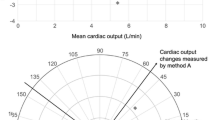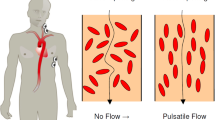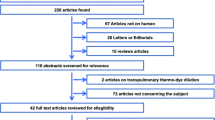Abstract
Cardiac output (CO) plays a crucial role in the hemodynamic management of critically ill patients treated in the intensive care unit and in surgical patients undergoing major surgery. In the field of cardiovascular dynamics, innovative techniques for CO determination are increasingly available. Therefore, the number of studies comparing these techniques with a reference, such as pulmonary artery thermodilution, is rapidly growing. There are mainly two outcomes of such method comparison studies: (1) the accuracy of agreement and (2) the precision of agreement. The precision of agreement depends on the precision of each method, i.e., the precision that the studied and the reference technique are able to achieve. We call this “precision of method”. A decomposition of variance shows that method agreement does not only depend on the precision of method but also on another important source of variability, i.e., the method’s general variability about the true values. Ignorance of that fact leads to falsified conclusions about the precision of method of the studied technique. In CO studies, serial measurements are frequently confused with repeated measurements. But as the actual CO of a subject changes from assessment to assessment, there is no real repetition of a measurement. This situation equals a scenario in which single measurements are given for multiple true values per subject. In such a case it is not possible to assess the precision of method.



Similar content being viewed by others
References
Marik PE. Noninvasive cardiac output monitors: a state-of the-art review. J Cardiothorac Vasc Anesth. 2013;27(1):121–34. doi:10.1053/j.jvca.2012.03.022.
Saugel B, Cecconi M, Wagner JY, Reuter DA. Noninvasive continuous cardiac output monitoring in perioperative and intensive care medicine. Br J Anaesth. 2015;114(4):562–75. doi:10.1093/bja/aeu447.
Alhashemi JA, Cecconi M, Hofer CK. Cardiac output monitoring: an integrative perspective. Crit Care. 2011;15(2):214. doi:10.1186/cc9996.
Ganz W, Donoso R, Marcus HS, Forrester JS, Swan HJ. A new technique for measurement of cardiac output by thermodilution in man. Am J Cardiol. 1971;27(4):392–6.
Swan HJ, Ganz W, Forrester J, Marcus H, Diamond G, Chonette D. Catheterization of the heart in man with use of a flow-directed balloon-tipped catheter. N Engl J Med. 1970;283(9):447–51. doi:10.1056/NEJM197008272830902.
Sakka SG, Reinhart K, Meier-Hellmann A. Comparison of pulmonary artery and arterial thermodilution cardiac output in critically ill patients. Intensive Care Med. 1999;25(8):843–6.
Sakka SG, Reinhart K, Wegscheider K, Meier-Hellmann A. Is the placement of a pulmonary artery catheter still justified solely for the measurement of cardiac output? J Cardiothorac Vasc Anesth. 2000;14(2):119–24.
Marx G, Schuerholz T, Sumpelmann R, Simon T, Leuwer M. Comparison of cardiac output measurements by arterial trans-cardiopulmonary and pulmonary arterial thermodilution with direct Fick in septic shock. Eur J Anaesthesiol. 2005;22(2):129–34.
Altman DG, Bland JM. Measurement in medicine: the analysis of method comparison studies. Statistician. 1983;32(32):307–17.
Bland JM, Altman DG. Statistical methods for assessing agreement between two methods of clinical measurement. Lancet. 1986;1(8476):307–10.
Bland JM, Altman DG. Measuring agreement in method comparison studies. Stat Methods Med Res. 1999;8(2):135–60.
Bland JM, Altman DG. Agreement between methods of measurement with multiple observations per individual. J Biopharm Stat. 2007;17(4):571–82. doi:10.1080/10543400701329422.
Critchley LA, Critchley JA. A meta-analysis of studies using bias and precision statistics to compare cardiac output measurement techniques. J Clin Monit Comput. 1999;15(2):85–91.
Cecconi M, Rhodes A, Poloniecki J, Della Rocca G, Grounds RM. Bench-to-bedside review: the importance of the precision of the reference technique in method comparison studies—with specific reference to the measurement of cardiac output. Crit Care. 2009;13(1):201. doi:10.1186/cc7129.
Critchley LA. Bias and precision statistics: should we still adhere to the 30 % benchmark for cardiac output monitor validation studies? Anesthesiology. 2011;114(5):1245. doi:10.1097/ALN.0b013e318215e1e5 author reply 1245–1246.
Squara P, Imhoff M, Cecconi M. Metrology in medicine: from measurements to decision, with specific reference to anesthesia and intensive care. Anesth Analg. 2015;120(1):66–75. doi:10.1213/ane.0000000000000477.
Peyton PJ, Chong SW. Minimally invasive measurement of cardiac output during surgery and critical care: a meta-analysis of accuracy and precision. Anesthesiology. 2010;113(5):1220–35. doi:10.1097/ALN.0b013e3181ee3130.
Hunsicker O, Feldheiser A, Wernecke KD, Spies C. Assessment of agreement and trending between haemodynamic monitors is still challenging. Intensive Care Med. 2014;40(5):767. doi:10.1007/s00134-014-3268-x.
Petzoldt M, Saugel B, Reuter DA. How precise is “precision” of hemodynamic measurements in clinical validation studies? Intensive Care Med. 2014;40(7):1064. doi:10.1007/s00134-014-3317-5.
Streiner DL, Norman GR. “Precision” and “accuracy”: two terms that are neither. J Clin Epidemiol. 2006;59(4):327–30. doi:10.1016/j.jclinepi.2005.09.005.
Conflict of interest
The authors declare that they have no conflict of interest.
Compliance with ethical standards
The research did not involve human participants or animals.
Author information
Authors and Affiliations
Corresponding author
Rights and permissions
About this article
Cite this article
Hapfelmeier, A., Cecconi, M. & Saugel, B. Cardiac output method comparison studies: the relation of the precision of agreement and the precision of method. J Clin Monit Comput 30, 149–155 (2016). https://doi.org/10.1007/s10877-015-9711-x
Received:
Accepted:
Published:
Issue Date:
DOI: https://doi.org/10.1007/s10877-015-9711-x




